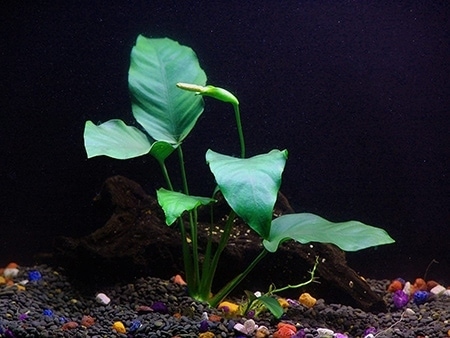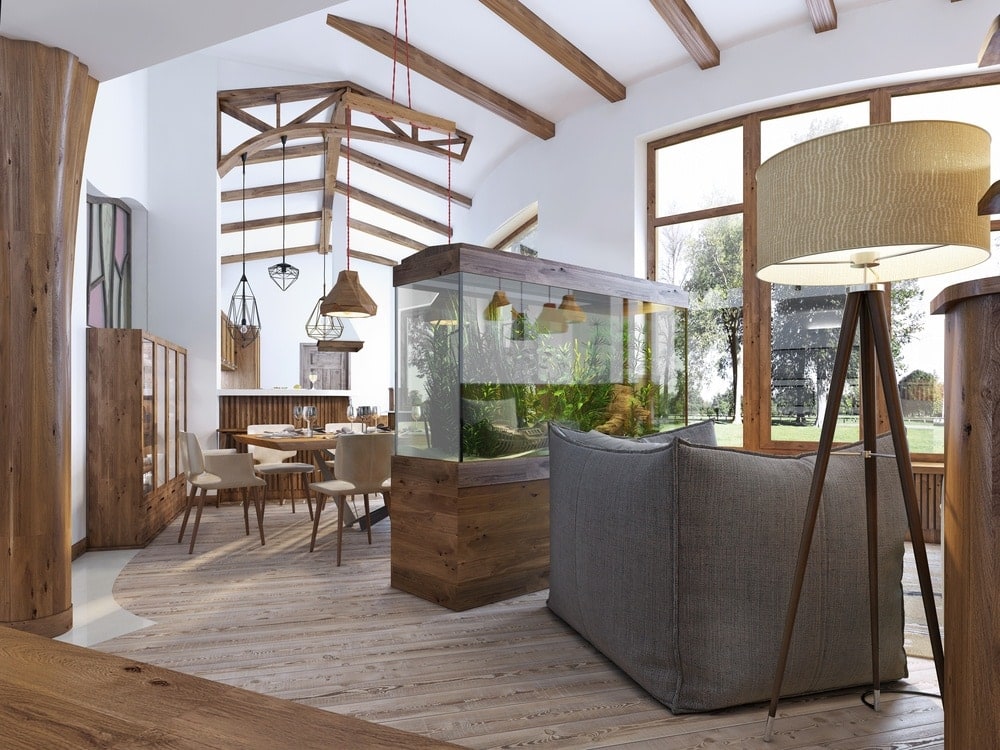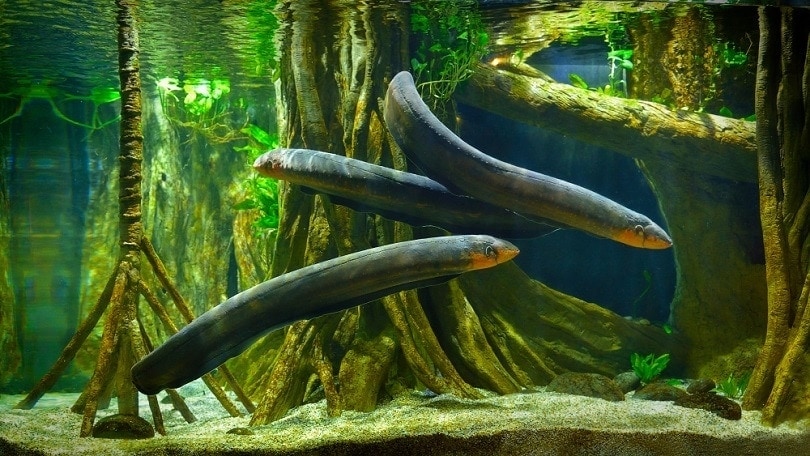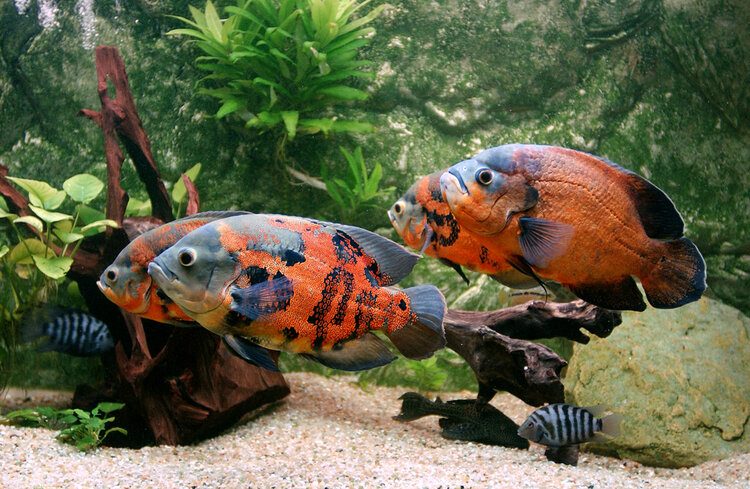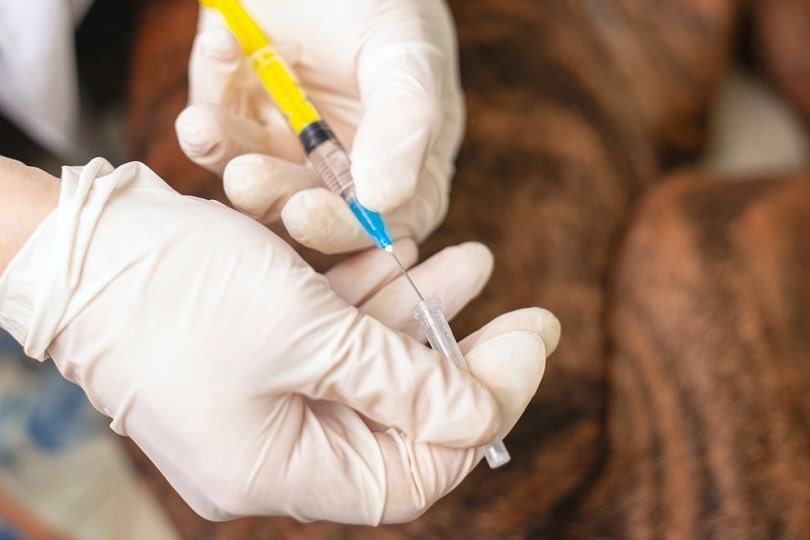12 Best Tall Aquarium Plants – 2024 Reviews and Top Picks

Updated on
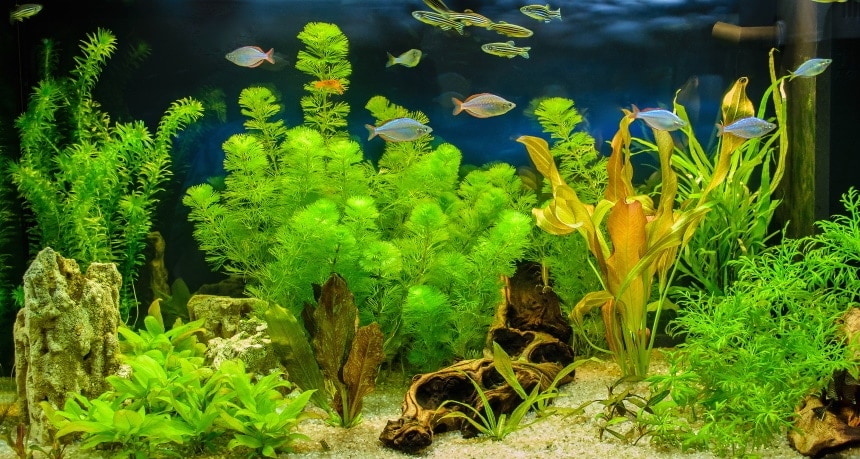
Aquarium plants serve a greater purpose than just keeping up with the fish Joneses. Plants absorb CO2 and toxins from the water while releasing oxygen needed by the living things in the tank. Tall plants make an appealing backdrop, bringing all the good things about plants to the tank without blocking your view of your beautiful aquatic friends.
Knowing which plants to choose can be overwhelming, though, especially if you’re new to aquarium keeping. These reviews are here to help you make informed decisions for the health of your tank without losing sight of aesthetics.
After all, don’t we all love to sit and experience the joy of our tanks while making the best decisions for our pets?

A Quick Comparison of Our Winners (2024)
| Rating | Image | Product | Details | |
|---|---|---|---|---|
| Best Overall |
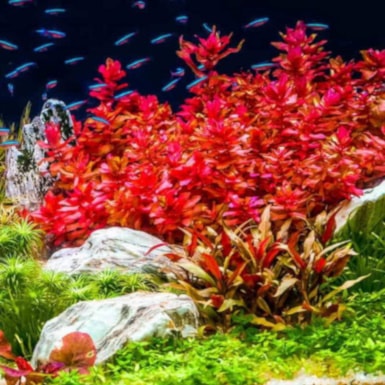
|
Creeping Primrose Willow |
|
Check Price |
| Best Value |

|
Hornwort |
|
Check Price |
| Premium Choice |

|
Roundleaf Toothcup |
|
Check Price |
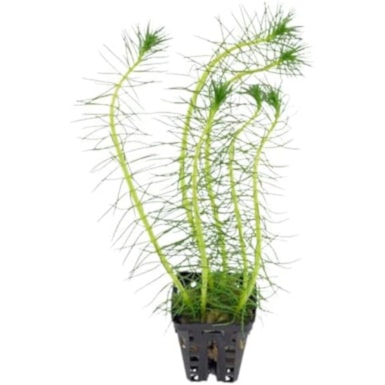
|
Foxtail |
|
Check Price | |

|
Java Fern |
|
Check Price |
The 12 Best Tall Aquarium Plants
1. Creeping Primrose Willow – Best Overall
| Growth Rate: | Moderate |
| Max Height: | 20 Inches |
| Light Demands: | Medium |
| CO2: | Environmental |
| Difficulty: | Easy |
The best aquarium plants are those that offer protection and cover for fish, but that also look good in the aquarium. One of the joys of keeping fish is that they are relaxing to watch as they swim around, but if you have ugly aquarium plants, it can detract from the overall appeal.
Creeping Primrose Willow is most commonly used as background decoration and the red color of these plants will really bring the colors of some tank inhabitants to life. The plant itself will grow to around 20 inches and is a moderate grower.
It doesn’t need CO2 supplementation, but it will need regular fertilization to get the most growth from the willow. It also requires decent lighting, but it will thrive in a varied range of water conditions including different temperatures and pH values. Its ability to grow in different water parameters, its attractive look, and its lack of CO2 supplementation make this the best overall tall aquarium plant and is especially suitable for beginners.
- Thrives in a wide range of water temperatures
- Suitable for beginners to grow
- No need for CO2 supplementation
- Does need fertilization
- Requires appropriate lighting
2. Hornwort – Best Value
| Growth Rate: | Fast |
| Max Height: | 10 feet |
| Light Demands: | Moderate |
| CO2: | Environmental |
| Difficulty: | Easy |
If you’re looking for a plant that will grow as tall as your aquarium water is deep, then look no further than Hornwort. Hornwort can grow up to 10 feet, although you can obviously keep it shorter than this in a smaller tank. It also grows quickly, and it can either be planted or floated. Floating the plant means there is no need for fertilization, but it also means that the placement of the plant will be subject to the whims of the water’s current.
Although it isn’t necessarily the cheapest plant to buy, it does grow big and it grows quickly, offering a lot of coverage for your money, which makes it our choice as the best tall aquarium plant for the money. It is considered a good plant for beginners because it can be floated and also because it can grow in freshwater or saltwater, and it will even grow well in outdoor ponds. Most fish will leave it alone but if yours do try and eat it, you will be left with needles floating in the tank that require cleanup.
- Grows up to 10 feet tall
- Can be planted or left to float
- Suitable for virtually all tank setups
- Can increase water cleaning requirements
3. Roundleaf Toothcup – Premium Choice
| Growth Rate: | Moderate |
| Max Height: | 15 Inches |
| Light Demands: | High |
| CO2: | Supplement |
| Difficulty: | Moderate |
CO2 supplementation requires the addition of some kind of supplement. These supplements tend to consist of yeast that will multiply in the water and produce carbon dioxide. CO2 addition isn’t too challenging, but you do need to monitor CO2 levels because too much can prove fatal for fish. But the good news is that CO2 supplementation, combined with light, can help prevent algae growth.
If you are willing to put in the extra work and invest in CO2 supplementation kits, Roundleaf Toothcup is a good choice of plant for your aquarium. It grows to around 15 inches tall, so there are certainly taller plants, but when it has appropriate CO2 levels, its leaves have a red tinge, and the plant is bushy in nature so it can cover a lot of the background of your tank to give a great overall effect. This species of aquarium plant does also benefit from around 8 hours of light per day, so it may not be a good choice as a tankmate for fish that prefer dark and murky waters.
Beyond the CO2 supplementation and light requirements, though, the plant has minimal nutritional requirements so you may not even need to fertilize.
- Pretty red leaves
- Side stems give the plant a bushy look and good coverage
- Low nutrition needs
- Needs light
- Benefits from CO2 supplementation
4. Foxtail
| Growth Rate: | Fast |
| Max Height: | 24 Inches |
| Light Demands: | Moderate |
| CO2: | Environmental |
| Difficulty: | Easy |
Green Myrio Foxtail is so called because the shape of the plant resembles that of a fox’s tail, although it is green rather than red. The plant is fast growing and most genus grow to around 24 inches, although some will grow to 4 feet tall. It can be left to float in the tank with minimal effort required to encourage growth. However, if you do provide it with light during its early growth stages and offer some fertilizer while it is growing, you will enjoy optimal growth.
There’s no need for CO2 supplementation and it does well in most water temperatures, pH levels, and water hardness ratings.
- No need for CO2 supplementation
- Rapid growth
- Can be left to float with minimal care required
- Extra care needed for optimal growth
5. Java Fern
| Growth Rate: | Moderate |
| Max Height: | 15 Inches |
| Light Demands: | Low |
| CO2: | Environmental |
| Difficulty: | Easy |
The Java Fern is arguably one of the easiest aquarium plants to care for, and with minimal effort, it will even help you manage your aquarium. It can be grown in freshwater aquariums and is popular for its beautiful leaves. It grows to around 15 inches in height and provides cover for your fish. It can be grown in most tanks, regardless of conditions, and it oxygenates the water while also helping prevent algae growth.
Because of its popularity, it is also readily available and is one of the cheaper tall aquarium plants you can buy. It doesn’t need CO2 supplementation or special lighting requirements. It really is a dream to keep, but there are taller plants out there.
- Can thrive in a variety of conditions
- Inexpensive
- Can oxygenate the water
- Not very tall
6. Anubias barteri
| Growth Rate: | Slow |
| Max Height: | 16 inches |
| Light Demands: | Low |
| CO2: | Environmental, Supplemental |
| Difficulty: | Easy |
Anubias come in a wide variety of sizes, but when looking for a tall aquarium plant, Anubias barteri is the best option. This plant is nearly foolproof for beginners, and its beautiful, broad leaves make a nice aesthetic addition to any tank. Anubias plants do not need to be planted in substrate but can tolerate gravel or sand. These plants have rhizomes versus true roots, so they are happiest when they are not planted but instead attached to a hard surface like driftwood.
With a new Anubias barteri, you will likely need to attach it to the surface with plant and aquarium-safe glue or by gently weighing it down. Over time, the plant will attach itself and will eventually put out new rhizomes that can be propagated into new plants. Anubias do not require additional CO2 in the tank but will grow best with some supplementation. Some of the best features of Anubias are its low light requirement and its hardiness. Be aware that Anubias barteri has a very slow growth rate compared to other hardy aquarium plants.
- Slow-growing and easy to maintain
- Very hardy
- No extra CO2 necessary
- Good for all types of tanks
- Comes with driftwood attached
- Slow growth rate
- May require CO2 supplementation
- If not planted, needs to be attached to a surface to grow
7. Amazon Sword
| Growth Rate: | Moderate |
| Max Height: | 20 inches |
| Light Demands: | Moderate |
| CO2: | Environmental, Supplemental |
| Difficulty: | Easy |
The Amazon Sword is another tall aquarium plant that is great for beginners. It does best with CO2 supplementation but does not require it. Amazon Swords absorb most of their nutrients via their roots, so it is recommended to plant them into nutrient-rich aquarium substrate to maximize health and growth. They will put their roots deep into the substrate, so be aware of this when planting near other plants.
Amazon Swords are so named because the plant is relatively stout and bushy, but the leaves are long and pointed with a sword-like appearance. They can reach up to 20 inches in height but most commonly grow to around 12-14 inches. They are a deep green color and will begin to change to brown or red when they lack nutrients. There are other varieties of Swords that come in a wide shade range. When they get tall enough, these plants can serve as a hiding spot for shy fish. These plants can be propagated from runners or rhizomes and are excellent oxygenators.
- Good for beginners
- Lush appearance
- Easy to propagate
- Widely available
- Great hiding spot for shy fish
- Excellent oxygenator
- Doesn’t do well in brackish water
8. Water Wisteria
| Growth Rate: | Fast |
| Max Height: | 20 inches |
| Light Demands: | Moderate |
| CO2: | Environmental |
| Difficulty: | Easy |
Water wisteria is one of the most diverse aquarium plants because while it makes an excellent background plant, it can also be used as a tank carpet. Also, the size and shape of its leaves are directly affected by the environment it’s in, so it can change its appearance over time. Some fish enjoy eating Water Wisteria, but it has an exceptionally rapid growth rate, so it often grows back before the fish can kill the plant. If allowed to grow without trims this plant can outcompete other plants for nutrients and light, so keep this in mind when considering Water Wisteria for your tank.
This plant is so readily propagated from cuttings that stems drop during trims can root on their own. Water Wisteria grows easily without supplementation but may strip nutrients from the water that are needed by other plants, so supplementation may become necessary if this plant is allowed to grow too large. It appreciates slightly acidic, warm water and oxygenates the water well.
- Slow-growing and easy to maintain
- Very hardy
- No extra CO2 necessary
- Good for all types of tanks
- Comes with driftwood attached
- Can consume nutrients needed by other plants
- Requires substrate for planting
- May root in unwanted places
- May require trims
- Moderate lighting requirements
9. Vallisneria
| Growth Rate: | Moderate |
| Max Height: | 3 feet |
| Light Demands: | Moderate |
| CO2: | Environmental, Supplemental |
| Difficulty: | Moderate |
Vallisneria comes in multiple varieties, all of which make for lovely aquarium plants. Thanks to the diversity of this plant, it can be used in the foreground, midground, or background of tanks. For anyone looking for a tall aquarium plant, though, the Vallisneria gigantea, also known as Eelgrass, makes a great choice. It reaches heights of around three feet and makes a nice hiding spot for shy aquarium pets. It does not require CO2 supplementation but grows best with it. However, too high of a CO2 dose can cause the tender leaves of the plant to melt and die.
Vallisneria leaves are damaged by rough handling but the plant is resilient and grows quickly. It reproduces by sending out runners from the mother plant, which can become separate plants once established. Vallisneria gigantea needs to be planted in sandy or other fine substrate and may require planting depths up to six inches. It is important not to plant it past the top part of the roots, called the crown, as this can kill the plant. Vallisneria grows best in slightly alkaline water.
- Moderate growth rate
- Provides cover to small animals
- Propagates easily
- Diverse
- May require added CO2
- Damaged leaves will die
- Needs adequate substrate for planting
- Less hardy than some other plants
- Moderate lighting needs
10. Rotala
| Growth Rate: | Fast |
| Max Height: | 12 inches |
| Light Demands: | Moderate |
| CO2: | Environmental, Supplemental |
| Difficulty: | Easy |
Rotala plants are known for the tiny oxygen bubbles that collect on the leaves, giving them a unique and elegant appearance. It can grow out above the top of the water, which also adds to its elegant appearance. This plant is a favorite of many small fish and is often used for shrimp breeding as well. It grows rapidly and gets tall and wide, so it may require some trimming. In low lighting, it will be green or yellow and will eventually drop its leaves. In high or moderate lighting, Rotala becomes colorful, occurring in shades of purple, red, and pink.
Rotala plants do not require substrate and will appreciate supplemental CO2, but this is not necessary for them to grow. It comes in multiple varieties, with Rotala rotundifolia usually being the most accessible variety.
- Colorful and lush
- Variable lighting options
- Elegant in appearance
- Shelter for small fish, fry, and shrimp
- Substrate is required
- High or moderate lighting is ideal
- Grows best with CO2 supplementation
- May need routine trims
11. Brazilian Pennywort
| Growth Rate: | Fast |
| Max Height: | 2 feet |
| Light Demands: | Moderate |
| CO2: | Environmental |
| Difficulty: | Easy |
Brazilian Pennywort is a unique-looking plant and can be planted in substrate or left to float. It is a flowering plant and can grow above the water level. Like Bacopa caroliniana, this plant can also be found growing on the land near bodies of water. Pennywort is extremely fast-growing, up to a few inches per week. It tolerates a broad range of water parameters, and while it prefers moderate to high lighting, it will still grow well in low light conditions. It does not require supplemental CO2 but grows best when it is provided.
Many fish enjoy swimming through and hiding in Pennywort, but goldfish and some cichlids will enjoy eating this plant, so this one may need to be avoided if you aren’t interested in losing your plants to your snacking fish.
- Rapid growth rate
- Tolerates many water and light conditions
- Hiding spots for small fish
- Good choice for grazers
- Good choice for beginners
- Unique appearance
- Prefers supplemental CO2
- Goldfish and cichlids may decimate this plant
- Prefers moderate to high lighting
12. Cabomba/Fanwort
| Growth Rate: | Fast |
| Max Height: | 20 inches |
| Light Demands: | High |
| CO2: | Environmental, Supplemental |
| Difficulty: | Easy |
Cabomba is a great tall plant for tanks and ponds, but the first consideration you should have about this plant is finding out if it is legal to own in your area. Because Cabomba can become invasive in the right environment, some states do not allow for its sale or import due to its negative impact on non-native environments. Like Hornwort, Cabomba can be planted in substrate as well as floated and it grows rapidly. It is similar in appearance to Hornwort as well, except it is less prickly and fuller and bushier. In moderate to high lighting this plant can grow in a variety of colors. Even the green varieties of Cabomba can take on a purplish tinge under these lighting conditions. It can tolerate low light but will not be as colorful. It does best in slightly acidic, warm water with CO2 supplementation.
Cabomba is native to the Carolinas, so recreating its preferred growing conditions of high humidity and warmth will be most successful.
- Good for beginners
- Attractive foliage and colorful
- Can tolerate a variety of lighting conditions
- Full and lush
- Can be planted or floated
- Easy to propagate
- Extremely invasive in some areas
- May require CO2 supplementation
- Grows best with moderate to high lighting
Buyer’s Guide: How to Select the Best Tall Aquarium Plants
What to Look for in Tall Aquarium Plants
When shopping for aquarium plants, make sure to pick plants that are an appropriate color for their species and variety. For plants with roots or rhizomes, look for those that are well-developed and healthy appearing. Pick plants that are full and lush and appear to have good growth. If the plant appears healthy and has offshoots that also appear healthy, then this is likely a plant that has been well cared for.
What to Avoid
Avoid picking plants that have brown or black leaves or stems as these may be unhealthy or dying. Knowing which plants change color in different lighting versus plants that should maintain a singular color will help you make the distinction between healthy and unhealthy plants. Make sure to check new plants thoroughly to ensure you don’t have any hitch-hiking snails. Some types of snails can be extremely difficult to get rid of once introduced into your tank and can be detrimental to the health of plants and other aquarium animals.
When purchasing plants in person, check the tank they are in thoroughly for snails as well. If you spot snails on other plants in the tank, then all of them likely have snails. Some plants can be purchased pre-packaged and snail free. This lessens the risk of snails significantly but still check these plants over as well.
How to Safely Introduce New Plants to Your Aquarium
The safest thing you can do when bringing home any new living thing for your aquarium, whether it’s plants or animals, is use a quarantine tank. Quarantine new plants for two weeks or more to ensure they are not going to transmit snails or diseases into your tank. Always purchase plants from online or in-person stores, do not take plants from the natural environment for your tank.
Something to Keep in Mind
Never release plants into the natural environment as this can lead to damage within the ecosystem. If you have an outdoor pond, ensure the plants you choose are not going to take root or grow in local bodies of water if the plants are swept away by a flood or storm.

Conclusion
To recap, our top choice is the Creeping Primrose Willow as the red color of these plants really brings out the colors of some tank inhabitants. Hornwort grows quickly, and it can either be planted or floated, plus will grow as tall as your aquarium, making it our best value choice.
Tall aquarium plants can bring almost as much life to your aquarium as your fish do. Hopefully, these reviews will help you choose the plants that fit your tank’s aesthetic the best.
Featured Image Credit: Andrey_Nikitin, Shutterstock



